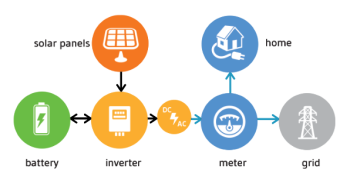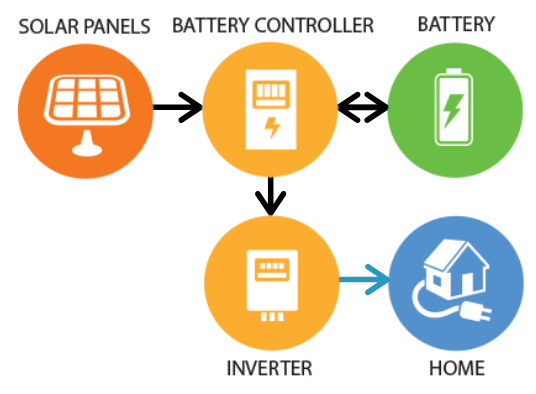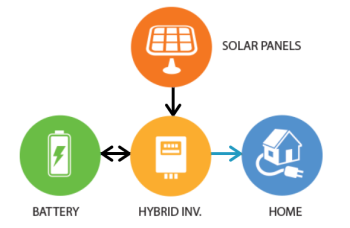Everyone wants to know about battery storage, it’s the hot topic on the lips of everyone with even a passing interest in renewable energy. There’s no doubt that battery technology is the way of the future and the next major step towards home energy independence from the grid. Read on to learn everything you need to know about the topic.
Solar battery systems work by storing excess solar power produced during the day for later use in the evening. More cost-effective than selling it back to your retailer during the day at a cheaper rate, this allows you to use more of your system’s production and further reduce your reliance on the grid, saving you more than you would otherwise.
Types of Systems

On a time-of-use tariff, you can also purchase grid power during cheaper periods, reducing how much you need to purchase during peak periods by reserving power in the storage system until you need it. Battery systems can also be configured to provide power in an outage, keeping the essential systems in your home running. There are a few different types of storage systems like Hybrid inverters, AC Coupled and DC Coupled solutions. Our consultants can help you pick the one right for your home, and your unique solar energy system requirements and needs.

Installed between the solar panels and the inverter, a DC Coupled Storage system detects when there is excess power production and redirects it to the batteries. Later, when you’re consuming more power than you're producing, the stored power is then released to your inverter and from there into your home’s system.
One advantage of this system is that the power is stored in the batteries before it is converted into AC, saving on unnecessary conversions between DC and AC later on. A limitation of this configuration is that you're unable to draw power from the grid and store it in your battery for use later on during high peak periods. This type of system also cannot be configured to provide power during a grid outage. This solution, however, is cost-effective, efficient and usually quite easy to retrofit into existing systems, making it the optimal solution for many homes.

AC coupled storage is the most common system type currently available on the market. While not as efficient or as cost-effective as storing solar energy as DC coupled, AC coupled solutions have a number of significant advantages over DC-coupled systems.
AC coupled storage can draw power from the grid, allowing homeowners to purchase power at cheaper rates, ensuring you don't draw from the grid at peak times when power is most expensive. AC coupled systems can also be configured to provide battery backup and store excess solar energy. AC coupled systems work independently of the home’s solar power system, so they can easily be retrofitted while allowing you to draw on other energy sources such as ancillary generators. Many of these are currently in use today, these systems are tried and tested, and have proven themselves many times over.

Hybrid inverters are purpose-built for to unite solar and batteries, providing significant advantages thanks to their focused design. Hybrid inverters are technically DC and AC coupled solutions, so you receive the benefits of both. They allow you to store power in the battery before it’s converted from DC to AC, saving on unnecessary future conversions. As it is also AC coupled, you can still incorporate features such as battery backup and the storing of power during cheaper non-peak periods. All the monitoring is also conducted by a centralised unit, so you don't have to worry about separate monitoring packages for both your storage and solar systems. We are now seeing more and more of these units as they’re a great fit for residents looking to incorporate solar and storage together into one complete, powerful package.
The financial benefits of battery storage
As time goes on the price of battery systems have continued to fall, and the government has continued to introduce incentives to encourage consumers to install these storage systems. This is because as more and more people have installed solar energy systems across Australia, the grid has struggled to keep up with the energy being exported to it. This is why feed-in tariffs have started to fall in recent years, as there is more and more energy being sent to the grid, creating grid instability due to constant voltage rise.
The latest of these government incentives is the Distributed Energy Buyback Scheme or DEBS, which offers those exporting to the grid far better rates during high-peak hours, encouraging the storage of energy gathered during the day, rather than releasing it as soon as it’s generated in the height of noon. You can read more about the DEBS scheme here.
More and more of similar local and national incentives are being introduced around Australia, and with batteries being more affordable than ever, this is a fantastic time to consider them for your home.
Installation Information
Below you can find information on a variety of different topics surrounding battery installations and how battery storage systems can add to your home.
To retrofit a battery system into a home with an existing solar power system all you’ll need to do is add a battery inverter, metering unit (not the one your energy retailer uses) and the battery itself to your system.
You may be saying, ‘I already have an inverter in my solar energy system,’ but it’s worth noting that a battery inverter and a solar inverter are not quite the same thing. A hybrid inverter can operate as both.
A solar inverter converts DC power from the panels into AC power for your home. A battery inverter needs to convert DC power from the batteries into AC power for the home and convert AC power from the home (which could come from the grid or from your solar energy system) to DC power so that it can be stored in the batter system. Batteries store power can only store energy in the form of DC, so the inverter needs to be able to do this back-and-forth conversion repeatedly and efficiently for you to make use of the stored energy.
We should let you know that this particular retrofit will not give your home the ability to use backup power. See the backup power section further down for more information on the topic.
Provided you’re not manipulating TOU tariffs or looking to sell power back at peak times, the best time to store power is when you’re producing excess. And the best time to use your stored power is when your solar power system is not covering your energy demand, such as when the sun is down and you would otherwise need to draw power from the grid.
The metering unit is an important part of a home energy storage system, as it tells the battery inverter how your system and home are using the energy so that it knows when it’s time to store energy, and when it’s time to draw on what’s been stored. This device is mounted near or in your switchboard. Linking it into your overall power system.
Each battery inverter is compatible with its own metering device and we have a wide range available to fit with many different inverters, including the Fronius Smart Meter, Enphase Envoy-S Metered and SMA Energy Meter.
This question is largely subjective and up to interpretation by the individual, so we’ll give you our take on this issue, and explain how we reached this conclusion.
Battery-compatible systems are systems where you can add a battery with a battery inverter (see above, retrofitting to existing solar power system) and all the necessary components. All solar power systems currently installed fit into this category with the limitation that the majority (but not all) of them cannot be configured to provide backup power.
We see a battery-ready system as a system that has all the additional components installed. One that’s ready for you to add batteries whenever you believe it would most benefit your home’s energy needs.
For example when you have a hybrid inverter installed (or a battery inverter), which enables you to connect the batteries directly to the inverter and the metering component that is already installed. This is what Solargain considers to be a battery ready system.
A backup-ready system is any system with or without batteries, that can be configured with an Automatic Transfer Switch (ATS) to provide power in case of an outage. Not all hybrid and battery inverters have this functionality available, so if you’re looking to set your home up with a backup system then make sure you ask about this feature when you’re purchasing your system. The Fronius Symo Hybrid is an example of an inverter that’s backup power ready, requiring only a firmware update and an ATS. Many other hybrid and battery inverters don’t have this capability and would need to be replaced completely. For more information, see the backup power section below.
It should be clear that having batteries doesn’t automatically mean you have backup power. Backup power requires additional components and not all battery inverters and hybrid inverters can be made to provide backup power even with these components. The first issue with backup power is the need to prevent power from being returned to the grid. With new backup systems, this is done with an Automatic Transfer Switch (ATS) that turns off in a grid outage and reactivates when the grid reactivates. Once this switch has been turned off, it needs to communicate to the backup-capable inverter that it can now create power safely.
Having an existing solar power system can work against you when it comes to backup functionality. When your backup system is producing power, the existing inverter will also begin creating power, mistaking it for the grid. When this happens, the power from the existing inverter means there is either too much or too little power available which then cannot be controlled by the backup inverter and the entire system will shut off.
Some inverters can be controlled by the backup inverter, which prevents this issue. Having a hybrid inverter can also prevent this, as having everything in the one device makes this a non-issue. This is why you’ll likely need to replace your existing solar inverter if you want to add backup power to your home’s solar power system, and is why we generally have been recommending hybrid inverters more and more as backup power and battery storage options become a more common concern for the average consumer.
When making use of backup power, if your backup system is unable to meet the required demand, it will shut down. For example, if your air-conditioner is switched on and an outage occurs, most backup systems won't be able to accommodate this power requirement. Some air conditioners can consume over 5,000W when they’re running, so, while you may have a full battery, your system shuts off because you cannot meet the outgoing power demand. For this reason, we recommend segregating your essential loads in the house, so that, in the event of a grid outage, non-essential devices are switched off automatically and only essential loads, such as refrigeration, lighting, and potentially medical equipment are covered.
These essential loads will need to be on a separate circuit or circuits and could include whatever you like. We’d recommend low-power loads like lights and fridges, from there you could also add your Wi-Fi, security system, any medical equipment and even a few emergency power outlets. Note that the more you add, the greater the power you’ll need available and the less likely your system will be to be able to meet demand.
Backup power is completely different from off-grid power. Backup power makes a reserve of power available to your devices in the event of a grid outage to sustain them until grid power returns. Off-grid systems are designed to work consistently where there is no grid present. This requires additional components and requires the system to be able to accommodate the worst-case scenario, which can be a big ask in overcast conditions.
Normally you will also allow for other last resort electricity generators, such as a diesel generator. You pay a very large premium for these systems due to their extra components and sizable capacity. In going off-grid you’re also accepting a fair degree of risk, as one failed component could potentially result in complete system failure and leave your home with nothing to fall back upon. This is why it’s not advised to go off-grid if you have even a reasonably reliable connection available at your home.
If you would like to enquire about a battery system for your home, you can get in contact with us on 1300 73 93 55, or through our contact page. Alternatively, head on over to our battery specials page to see what deals we currently have going.




